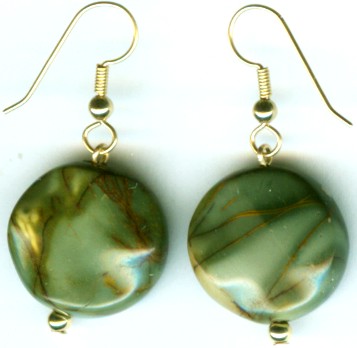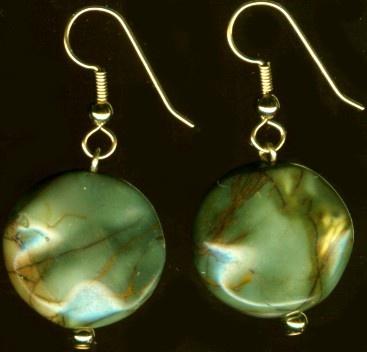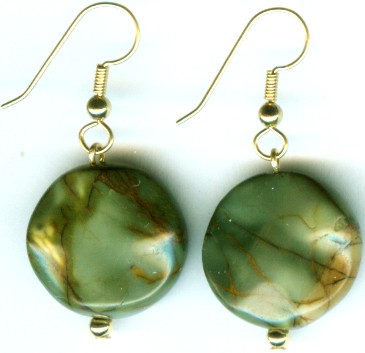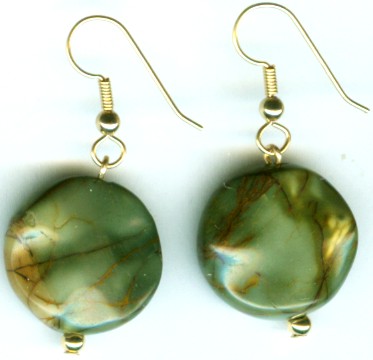|
For Customers outside of USA 
Two Genuine Natural Hand Crafted/Polished Nubian "Picasso" Jasper Semi-Precious Gemstones. Mounted onto High Quality 14kt Gold Fill French Hooks (not cheap gold electroplate). CLASSIFICATION: Polished Jasper Cabochon Semi-Precious Gemstones. Contemporary 14kt gold fill french hooks and straight pins. Sterling silver available if preferred. Also available in solid 14kt gold. ORIGIN: Nubia. Handcrafted in Siberian Southern Urals near Yekaterinburg. SIZE: Diameter: 20mm. Depth (Thickness): 6mm. Measurements approximate. WEIGHT: 48.25 carats (the pair).
NOTES: 14kt solid gold settings and other setting styles (euro clicks, lever backs, kidney wires, ball/stud dangles) are available upon request. DETAIL: Two very nice quality hand crafted/shaped/polished jasper semi-precious gemstones from the Nubian region of Southern Egypt/Sudan. Though this particular variety of Jasper, known contemporarily as "Picasso Jasper" did not figure specifically in the production of religious amulets in ancient Egypt, nonetheless the fabled land of ancient Nubia was the source of the red jasper held so precious by the Pharaohs of ancient Egypt. Carved into jewelry and religious amulets, red jasper was obtained from the Nubian Upper Nile, typically in the form of annual tributes to the Pharaoh. As well ancient Egypt received annual tribute of their treasured red jasper from "the land of Punt". But there exact whereabouts of Punt (and the pygmy black tribesmen of legend) remains a mystery today. A religiously significant amulet known as an "Isis Tit" was carved from red jasper and placed at the throat of the mummified remains of Egyptian Pharaohs and Royalty.
These two "Picasso" jasper gemstones originated from the same Nubian region which presently is part of both Southern Egypt and Northern Sudan. The gemstones were hand crafted by a Russian artisan, part of a centuries-old heritage renown for the production of the elaborate gemstones and jewelry of the Czars of Medieval, Renaissance, and Victorian Russia. Yes! These are natural gemstones, colored only by mother nature, they are not dyed. Jasper and other various varieties of agate have been popularly used through recorded history for the production of jewelry, beads, and amulets due to the vibrant rainbow of colors agate naturally occurs in. Agate amulets produced by Stone Age man in France has been discovered, dating the known use of agate back to approximately 20,000 B.C. Jasper maintained its immense popularity through Renaissance and into Victorian Europe. These are jewelry quality gemstones, and the coloration is absolutely exquisite. It takes no imagination to comprehend why it is referred to as "Picasso" jasper in the modern world. The gemstones have not been dyed or altered in any respect, except to be cut and polished. However under magnification the gemstones show the unmistakable characteristics of having been hand crafted. The coarseness of the handcrafted finish is considered appealing to most gemstone collectors, and is not considered a detriment, or to detract from the value of a gemstone. These characteristics are not only expected of hand-finished gemstones, most serious collectors consider such gemstones more desirable, possessed of greater character and uniqueness when compared to today's cookie-cutter mass-produced machine-faceted gemstones. Unlike today's computer controlled machine produced gemstones that approach flawlessness in a perfect finish, the cut and finish of a handcrafted gemstone such as this is the cultural legacy passed onwards by artisans who lived centuries ago. HISTORY: Jasper is a form of agate, and belongs to the chalcedony family of gemstones, a type of quartz. Jasper is very similar to citrine and amethyst in make up, but is so heavily included with elements such as iron and sulphur (which provide the colors) that they are opaque rather than transparent. The biggest difference between a Red Jasper and a Citrine is that there is probably 20 to 30% more Iron in the Jasper. The crystals in Jasper gemstones are so dense and so tightly compacted that they are invisible to the naked eye. It often contains organic material and mineral oxides which give it interesting patterns, bands and colors. Many of these patterns resemble landscapes with mountains and valleys.
Jasper was a favorite gem in ancient times and is referenced in Greek, Hebrew, Assyrian and Latin literature. The name Jasper comes to us from the Greek language. Jaspis or the ancient spelling Iaspis was the name of a mythical stone found in the head of the adder snake. Greek warriors carried one to give them courage in battle. Early Mediterranean shamans or wizards believed that jasper was a very sacred stone. Blue colored Jaspers were used to travel safely back and forth to the Spirit World. Red Jasper represented the blood of the Great Mother and was used to connect with the Earth in healing ceremonies. Green Jaspers were used to call the rain. Medieval authors of the 11th and 12th centuries wrote volumes about the protective powers of the Jasper. It was written that the gemstone could drive away evil spirits and protect the wearer from the bites of poisonous snakes and spiders. However mankind's relationship with Jasper, especially red jasper, is much more ancient than merely the Greeks, or medieval Europe. It dates back as early as (20,000 B.C.) in France where it was found to be used for ornamental objects, to the Babylonians times (1000 B.C.) where it was used in seals which have been found in ancient ruins. The Harrappa culture of India (4th millennia B.C.) also used this stone in their jewelry. The Egyptians used red jaspers to represent the blood of their goddess Isis. Amulets of the gem were said to have the same virtues as the goddess' blood and when worn helped prepare one for the judgment of Osiris upon death. Thus Chapter 156 of the Book of the Dead required the amulet in the form of the Girdle Tie of Isis, placed at the throat of the mummy, to be made of red jasper, whose blood-like coloring would enhance the words of the spell: 'You have your blood, Isis; you have your power.'
You can see an outstanding red jasper amulet of this style, courtesy of The British museum, by clicking right here. The ancient Egyptian word for red jasper, khenmet (hnmt), was derived from the verb "hnm", and meant "to delight". Red jasper was extremely popular in Ancient Egypt, expensive, and especially favored for use in earrings (click here to see red jasper earrings of ancient Egyptian/Nubian origin). Red jasper came to ancient Egypt from Nubia (a region laying between present-day Southern Egypt and Sudan) and from Punt (somewhere as yet unknown in Africa) in the form of regular tributes to the Pharaoh. In fact an ancient papyrus detailing the tribute from Nubia survives to present time (see here). Red jasper tributes from both Nubia and Punt were discovered in the Thebes tomb of Rekhmire and the tomb of Iamunedjeh; both were high officials of King Tuthmosis III (1450 BC). Agate itself (of which Jasper is a "family member") is named after its ancient source, the Achates River in Sicily, now known as the Drillo River, which remains a major source of this gemstone (though some ancient historians believe that the word agate is derived from the Greek word "Agate??" - meaning happy). Agate was used by Stone Age man in France 20,000-16,000 B.C. The ancient Egyptians used it prior to 3000 B.C., and in the Ptolemaic Period carved agate scarabs. Agate was also extremely popular for us in jewelry in ancient Sumeria. Agate was highly valued as a talisman or amulet in many other ancient cultures. It was said to quench thirst and protect from fevers. Persian magicians were believed to possess the power to divert storms through the use of agate talismans. A famous collection of four thousand agate bowls was accumulated by Mithradates, king of Pontus, is illustrative of the high value the ancient world had for agate. Agate bowls were also popular in the Byzantine Empire. Collecting agate bowls became common among European royalty during the Renaissance and many museums in Europe, including the Louvre, have spectacular examples. The agate-working industry grew up centuries ago in the Idar-Oberstein district of Germany, where agates were abundant. From the 16th century onwards cameos were cut from agate where different colors occur in layers. The background material is cut away, leaving the cameo design in relief. At the same time in Torre del Greco (Italy), a similar technique was used to cut cameos from sea shells. Agate is a common semiprecious silica mineral, colorful microscopic crystals of quartz, a variety of chalcedony occurs in bands of varying color and transparency. Most agates occur in gas bubble cavities in eruptive rocks or ancient lava. Silica laded water is deposited within the bubbles, and coagulates to a silica gel, eventually crystallizing as quartz. One common form of such quartz is onyx. Agate is found in a wide variety of patterns and beautiful colors, and can be transparent to opaque. The primary sources of agate today are Brazil, Uruguay, China, India, Madagascar, Mexico, and the USA.
There are many varieties of quartz (including various agates and jaspers) which are not generally recognized as quartz. Purple quartz is known as amethyst; yellow quartz as "citrine", green quartz as "adventurine"; and ametrine is a variegated gemstone possessing a color somewhere between amethyst and citrine. More readily recognized varieties of quartz include smoky quartz, rose quartz, onyx, agates, chrysoprase, and rutilated quartz. Rock crystal is the clearest form of quartz. According to ancient history, the sun and universe were contained within an enormous crystal. Rock crystal was used in ancient times to make crystal balls and bowls. Since ancient times colorless quartz crystals have always been popular in jewelry due to mystical legends concerning the "power" of quartz crystals. Even today many people believe that wearing quartz crystals benefits a person's health and spiritual well being. Besides use as gemstones and decorative accoutrements, quartz was also ground by ancient cultures to produce primitive forms of glass and ceramics. For instance, the ancient Egyptians used ground quartz to produce turquoise colored "faience" beads and amulets. Ceramic "glass-like" beads were also produced by the ancient Sumerian and Babylonian cultures.
SHIPPING OPTIONS: All purchases are backed by an unlimited guarantee of satisfaction and authenticity. If for any reason you are not entirely satisfied with your purchase, you may return it for a complete and immediate refund of your entire purchase price. Most of these antique gemstones were originally part of two collections, one originating in India principally composed of gemstones originally mined in India, Burma, Ceylon, and Siam, and then hand faceted in India. The addition of a second accumulation of antique gemstones originally mined in the Urals in the mid to late 19th century (including alexandrite) completed the collection. These gemstones as well were hand finished. The Urals have been one of the world's major sources of precious and semi-precious gemstones for many centuries. As well, additional specimens are occasionally acquired from other institutions and dealers in Eastern Europe and Asia. These antique gemstones are now in the United States and are available for immediate delivery. We ship inventory from the USA order fulfillment center near Seattle, Washington. Your purchase will ordinarily be shipping within 48 hours of payment. A certificate of authenticity is available upon request. We prefer your personal check or money order over any other form of payment - and we will ship immediately upon receipt of your check (no "holds"). We will accept PayPal payments. Please see our "ADDITIONAL TERMS OF SALE".
|
|---|


